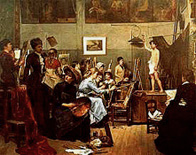

![]()
![]()
This Page:
Matilda C. Browne
Maria M.Brooks
Ida J. Burgess
M. Lesley Bush-Brown
Atha Haydock Caldwell
Katherine A. Carl
Mary Cassatt
Minerva Chapman
Alice Chittenden
Sarah Freeman Clarke
Gabrielle de Veaux Clements
Josephine Cochrane
![]()
![]()

Peonies--
representative work
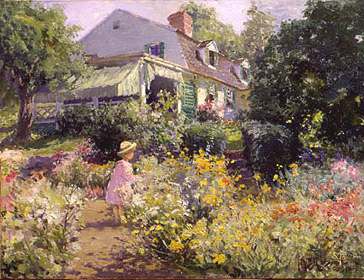
In Voorhees' Garden
--representative work
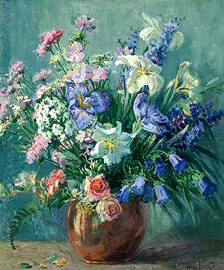
Floral Bouquet--
representative work
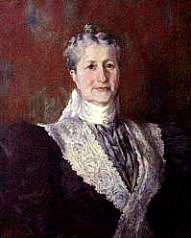
Old Woman
--representative work

The Herd Coming Home--representative work
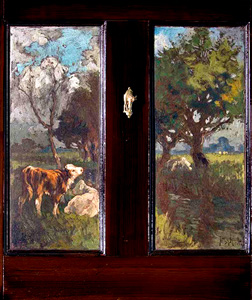
Bucolic Landscape--two door panels.
(Is the left one "Unwilling Model," listed below?)
An Unwilling Model c. 1892 (image unavailable)--
[a calf tied to a tree and
tugging on it] exhibited
in Fine Arts Palace, 1893 Exposition.
Born in Newark, New Jersey, Matilda Browne was a child protégé who began her art studies with artist-neighbor Thomas Moran, Eleanor and Kate Greatorex, and other local artists. Later studies were undertaken in Paris at the Académie Julian and in the Netherlands. She exhibited in Paris and Pennsylvania and was the first woman artist asked to join the famous art colony in Old Lyme, Connecticut. Browne also did book illustrations for her writer-husband Frederick Van Wyck. She received an Honorable Mention at the 1893 Exposition.
![]()
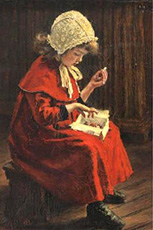
Candies--
representative work.
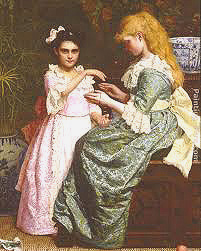
Cat's Cradle--
representative work

Down Piccadilly, returning from covent garden market
one June Morning 1882
--exhibited in the Rotunda,
Woman's Building, 1893 Exposition.
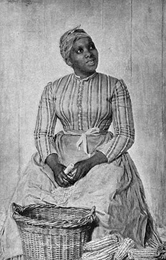
Shelling Corn--
representative work

Husking Corn--
representative work.
Either one of these paintings might be the one called Shucking Corn which was
exhibited in the Board Room,
Woman's Building, 1893 Exposition

The Wayfarers--exhibited in the
Rotunda, Woman's Building, 1893 Exposition.
Portrait of Reverend Dr. Morgan Dix (image unavailable)--exhibited
in the Board Room, Woman's Building, 1893 Exposition
Maria Brooks was born at Staines, Middlesex, England to Sophia and Henry Brooks. Her early gifts were not encouraged initially, but when the family moved to London, she began studying at the South Kensington Art School and later at the Royal Academy Schools. She was active in Montreal and Quebec City for one and a half years, before moving to New York where she maintained a permanent studio.
![]()
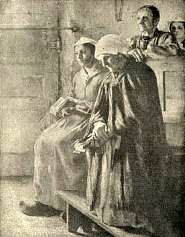
During Mass in Normandy--exhibited in
the Illinois Building, 1893 Exposition
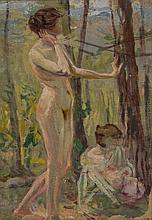
Nudes in the Forest
--representative work
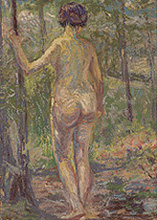
Nude in the Forest
--representative work.

A Song of Spring 1891--exhibited in
the Illinois Building, 1893 Exposition
Dawn and Learning--decorative murals
exhibited in Women's Reception Room,
Illinois Building, Burgess' "Dawn"
and Burgess' "Learning".
Still-life (image
unavailable)--
exhibited in the Illinois Building, 1893 Exposition
Ida J. Burgess was born in Chicago and began her art studies at the Cooper School of Design. She also studied art in New York at the Art Students League under William Merritt Chase and Walter Shirlaw and in Paris under L. D. Merson. At the 1893 exposition, her mural decoration could be seen in the Women's Reception Room of the Illinois State Building. She often exhibited and also worked with stained glass and wrote articles on that subject. She was a suffragist.
![]()
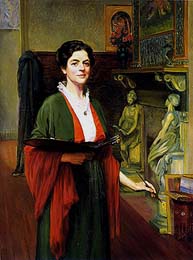
Self-Portrait--representative work

Portrait of Henry K.
Bush-Brown--
representative work
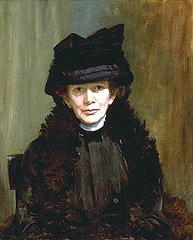
Ellen Day Hale
1910--
[National Museum of American Art,
Smithsonian] representative work.

New Parents--representative work
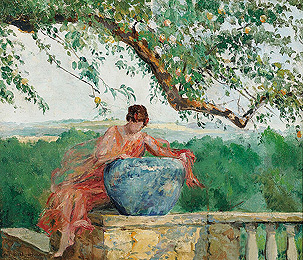
The Blue Jar--representative work
Wall mural--go to Woman's Building page;
exhibited in the Pennsylvania Building,
1893 Exposition.
Fragment of Mural Decoration for Music Room
(image unavailable)--may be the same as the
"wall mural" link in the previous entry; exhibited
in the Fine Arts Palace, 1893 Exposition.
A noted New York portrait painter and etcher, Margaret Bush-Brown was born to J. Peter Lesley, professor of geology and mining engineering at the University of Pennsylvania and to writer-social reformer Susan Lyman Lesley. She studied art at the Philadelphia School of Design for Women, at the Pennsylvania Academy of the Fine Arts with Thomas Eakins, and at the Académie Julian in Paris with Tony Robert-Fleury, Gustave Boulanger, and Jules-Joseph Lefebvre. She often summered along the East Coast with Cecilia Beaux and other women artists, developed her etching skills with Gabrielle De Vaus Clements, and toured France and Belgium with her distant artist-cousin Ellen Day Hale. She continued painting and exhibiting in New York after marrying sculptor Henry Kirke Bush-Brown, specializing later in portraits and miniatures in Washington, D.C.
![]()

The Old Howard, Sculley Square, Boston--representative work

A Beer Party 1910--representative work
Dolores and An Evening in October (images unavailable)
--exhibited in the Cincinnati Room in the Woman's
Building, 1893 Exposition.
Atha Haydock Caldwell was born in Cincinnati to Thomas T. Haydock, carriage manufacturer, and his wife Flora Rosella Sewall. By age seventeen, she was in Paris at the Académie Julian studying with Jules Dupré and beginning to exhibit. She traveled through North Africa, China, and Japan before returning the America. In 1898 she married William Caldwell, who became a professor at McGill University in Toronto, Canada where she lived the rest of her life.
![]()

Quarry Wall--representative work.

The Oriental Beauty)--exhibited
in Rotunda, Woman's
Building, 1893 Exposition.
Alternate title: Odalisque
(harem slave)

Portrait of Tzu Hsi (now CIXI),
Empress Dowager of China
1835-1908--exhibited
at 1904
at St. Louis Exposition.
Head of a Man (image unavailable)--
exhibited in Fine Arts Palace, 1893 Exposition
Soap Bubbles (image unavailable)--
exhibited in in the Rotunda, Woman's
Building, 1893 Exposition
Kate A. Carl was born in New Orleans and studied art at the Female Academy in Memphis, Tennessee and in Paris at the Académie Julian with William Adolphe Bouguereau, Tony Robert-Fleury, and later Hector Le Roux. Portraiture was her specialty. In 1903 she lived for ten months in Beijing at the Imperial Chinese Court while she painted a portrait of Tzu Hsi (CIXI), the last Empress Dowager of China, an experience Carl wrote about in her book With the Empress Dowager of China (1905). The portrait of the Empress Dowager, with an elaborate heavy frame (partially show here), was exhibited at the 1904 Louisiana Purchase Exposition in St. Louis. Carl lived in China until 1930, but maintained contacts with the art community in Memphis and, in her later years, had a studio on Washington Square in New York.
![]()
Go to separate web page:
Mary Cassatt's Lost Mural and Other Exhibits at 1893 World's Exposition
![]()

Self-image
--representative work.

Flanders Housewife
--representative work

Portrait of a
Bearded Man--
representative work
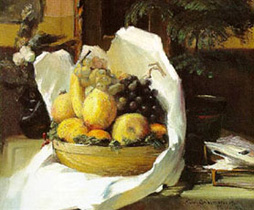
Souvenir de fête--
representative work

Woman Knitting--
representative work
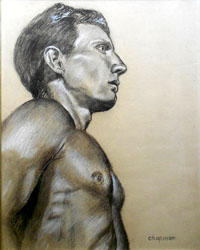
Figural Portrait--
representative work
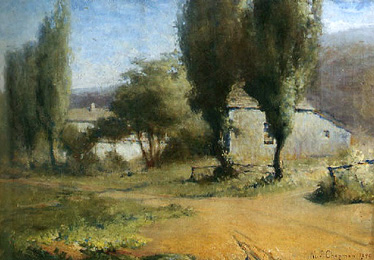
Turning in the Road--exhibited in the Rotunda,
Woman's Building, 1893 Exposition
The Village Church (image unavailable)--
exhibited in
Woman's Building, 1893 Exposition
Born in New York to Josephine and James L. Chapman who was a successful banker and tannery owner, Minerva Chapman grew up in Chicago. She graduated from Mount Holyoke College and attended the University of Chicago, studying privately in the early 1880s with Annie C. Shaw and, at the Art Institute of Chicago, with John Vanderpoel. From 1887 to 1897, she continued her studies in Paris at the Académie Julian and with a number artists such as impressionist Charles Augustus Lasar, as well as Collin, Courtois, Robert-Fleury, and Bouguereau. She frequently exhibited and won medals in both Paris, where she resided for much of her career, and in the United States, retiring in the 1920s to Palo Alto, California. She was the first woman president of the International Art Union and a founding member of the miniature painting society.
![]()
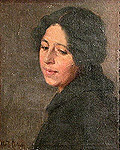
Self-Portrait--
representative work.
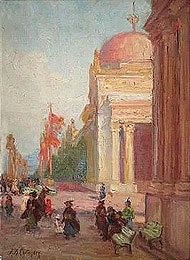
Pan Pacific International Exhibition--
representative work.

A Foothill Landscape
(Santa Lucia Mountains)
--representative work.
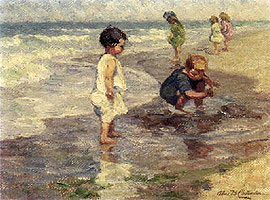
Children on a Beach
--representative work.

Children by the Sea
--representative work.
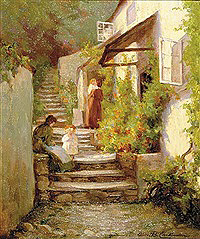
First Steps--
representative work.
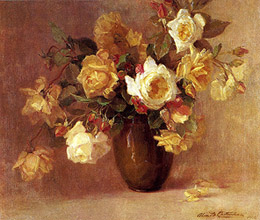
Roses in a Vase--representative work.

Autumn Cornucopia (Chrysanthemums) 1892
--this may be the "Chrysanthemums"
exhibited in the Art Gallery, California
State Building, 1893 Exposition.
Red Roses and Peonies (images unavailable)--exhibited in the
Art Gallery, California State Building, 1893 Exposition
Born in Brockport, NY, Alice Brown Chittenden was born in New York to Joseph Gladding Chittenden and Ann Miriam Green Chittenden and raised in San Francisco where, with the encouragement of her father (a prosperous miner), she studied art at the School of Design with Virgil Williams. She would later teach at that school for 43 years. Although she painted landscapes, she is especially remembered for her paintings of 350 varieties of California wildflowers. Over the years she also made several trips to New York, France, and Italy to study and exhibit. She was married to Charles Parshall Overton but divorced several years later.
![]()
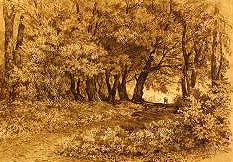
Villa Doria at Albano Nero, Rome 1851
--representative work.
Buried Temple of Esneh, Egypt (image
unavailable)--exhibited in the Board Room,
Woman's Building, 1893 Exposition
Sarah Freeman Clarke was born in Massachusetts and studied art under landscape painter Washington Allston. While living in Boston, she was actively involved in the Transcendentalist Movement, and she and her brother, unitarian minister and author James Freeman Clarke, were close friends with philosopher Ralph Waldo Emerson, Nathaniel Hawthorne's wife Sophia, and Margaret Fuller whom they accompanied on her western tour that led to her book Summer on the Lakes, illustrated by Sarah. For a time, she was the drawing teacher at Amos Bronson Alcott's Temple School. She also painted in Africa and Italy where she associated with sculptor Harriet Hosmer and the art colony of American expatriates immortalized in Hawthorne's novel The Marble Faun. After ten years abroad, she retired to Marietta, Georgia.
![]()
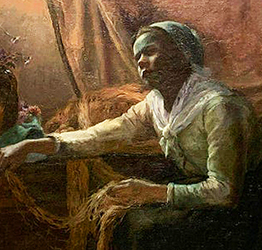
Portrait--representative work.
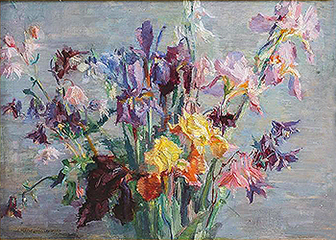
Irises--representative work.

Winter, Mount Vernon Place--
representative etching.

The Harbor, Baltimore 1926--
representative etching.
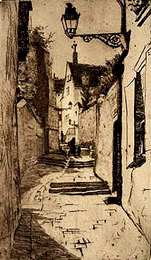
Way of St. Francis, Chartres [etching]--
exhibited in the Woman's Building, 1893 Exposition
Harvest--see the wall mural exhibited in the Ladies'
Reception
Room, the Pennsylvania State
Building, 1893 Exposition.
Two etchings--Chartres and Granite Quarry
(images unavailable)--exhibited in the
Woman's Building, 1893 Exposition
Gabrielle de Veaux Clements was a Philadelphia-born artist whose parents were Dr. Richard Clements and Gabrielle de Veaux from South Carolina. The younger Gabrielle studied at the Philadelphia School of Design for Women, the Pennsylvania Academy of Fine Arts, the Académie Julian in Paris, and in Italy. She also graduated from Cornell University in Ithaca, New York in 1880 with a B.S. degree in science. Clements met painter Ellen Day Hale in 1883; they became lifelong companions, summering in Rockport, Massachusetts with artists like Cecilia Beaux and wintering in Charleston where they taught etching, a skill which she also taught to Hale. Clements also taught art in Philadelphia and in Baltimore at Bryn Mawr School. Although she painted murals and portraits in her early career, she is remembered today primarily for her etchings.
![]()

The
Little Black Windmill--
representative work.

Darkey Town, Lynchburg, Virginia--
representative work.
Old Stone Stairway, Pont Aven, France
(image unavailable)--exhibited in the
Fine Arts Palace, 1893 Exposition
Josephine G. Cochrane was a Connecticut painter of landscapes and still lifes. She studied art in Paris at the Académie Julian. Evidently she sometimes exhibited under her initials: J. G. Cochrane. No more information is available online.
![]()
![]()
Go to U.S. Women Painters, p. 3
Return to Women Painters Index
Return to Site Index
![]()
![]()
Text written by K. L. Nichols
Painting, top of page: Marie Konstantinovna
Bashkirtseff,
In the Studio (1881).
Return to Nichols Home Page
Suggestions/Comments: knichols11@cox.net
Posted: 6-25-02; Updated: 5-3-20